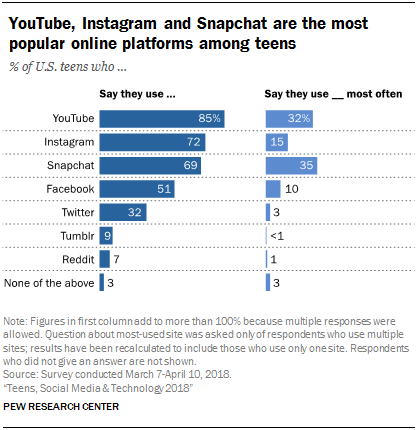most popular programming languages
++++++++++
more on coding in this IMS blog
https://blog.stcloudstate.edu/ims?s=coding
Digital Literacy for St. Cloud State University
++++++++++
more on coding in this IMS blog
https://blog.stcloudstate.edu/ims?s=coding
In higher education, 29.7% of all students are taking at least one distance course.
The total distance enrollments are composed of 14.3% of students (2,902,756)
taking exclusively distance courses and 15.4% (3,119,349) who are taking a
combination of distance and non-distance courses. The vast majority (4,999,112,
or 83.0%) of distance students are studying at the undergraduate level.
Almost half of the distance education students are concentrated in just five percent of the institutions, while the top 47 institutions, only 1.0% of the total, enroll 23.0% (1,385,307) of all distance students.
The total number of students studying on campus (those not taking any distance course or taking a combination of distance and non-distance courses) dropped by almost one million (931,317) between 2012 and 2015. The largest declines came at for-profit institutions, which saw a 31.4% drop, followed by 2-year public institutions, which saw a 10.4% decrease.
++++++++++++
https://www.bestcolleges.com/perspectives/annual-trends-in-online-education/
69% of online students identified employment as their primary goal for entering a program. 17% are grad students.
Seventy percent of administrators said they launch new programs with enrollment growth in mind, while meeting marketing and recruitment goals was their top concern.
++++++++++++
https://www.bestcolleges.com/perspectives/annual-student-guide-to-online-education/
++++++++++++++++
https://www.insidehighered.com/news/survey/survey-faculty-attitudes-technology
++++++++++
more on distance education in this IMS blog
https://blog.stcloudstate.edu/ims?s=distance+education
You can view clips from last week & sign up to join us Oct 19 at https://t.co/nC6HKCtdss. See you Saturday in #VR for an unforgettable learning experience! icymi @laura_mcbain @kwaku1 @stevensato @jelimad @oculus @htcvive @JaimeDonally @Rdene915 @teach42 @steve_bambury #ARVRinEDU https://t.co/Nmm8np5OPp
— Caitlin Krause #MindfulByDesign (@MindWise_CK) October 17, 2019
Join mindfulness sessions in VR, and leave refreshed, renewed, and better connected!
+++++++++
more on quantum computing in this IMS blog
https://blog.stcloudstate.edu/ims?s=quantum
Michael Niehoff October 2, 2019
https://www.iste.org/explore/Digital-citizenship/9-ways-real-students-use-social-media-for-good
+++++++++++++
more about social media in education in this IMS blog
https://blog.stcloudstate.edu/ims?s=social+media+education
Young people may be expert social-media and smartphone users, but many lack the digital skills they need for today’s jobs. How can we set them up for success?
https://www.theatlantic.com/sponsored/grow-google-2019/smartphone-generation-computer-help/3127/
Kenneth Cole’s classroom at the Boys & Girls Club of Dane County, located on a quiet residential street in Madison, Wisconsin.
The classes Cole teaches use Grow with Google’s Applied Digital Skills online curriculum.
One day he may lead Club members in a lesson on building digital resumes that can be customized quickly and make job-seeking easier when applying online. Another day they may create a blog. On this particular day, they drew up a budget for an upcoming event using a spreadsheet. For kids who are often glued to their smartphones, these types of digital tasks, surprisingly, can be new experiences.
The vast majority of young Americans have access to a smartphone, and nearly half say they are online “almost constantly.”

But although smartphones can be powerful learning tools when applied productively, these reports of hyperconnectivity and technological proficiency mask a deeper paucity of digital skills. This often-overlooked phenomenon is limiting some young people’s ability—particularly those in rural and low-income communities—to succeed in school and the workplace, where digital skills are increasingly required to collaborate effectively and complete everyday tasks.
According to a survey by Pew Research Center, only 17 percent of Americans are “digitally ready”—that is, confident using digital tools for learning. Meanwhile, in a separate study, American millennials ranked last among a group of their international peers when it came to “problem-solving in technology-rich environments,” such as sending and saving digital information
teach his sophomore pupils the technology skills they need in the workplace, as well as soft skills like teamwork.
+++++++++++++++++++++
more on digitally native in this IMS blog
https://blog.stcloudstate.edu/ims?s=digitally+native
more on millennials in this IMS blog
https://blog.stcloudstate.edu/ims?s=millennials
https://www.cnbc.com/2019/10/09/apple-augmented-reality-glasses-to-launch-in-2020-kuo.html
Companies like Microsoft, Google and the start-up Magic Leap have all released AR glasses over the years, but none have gained massive consumer adoption.
+++++++++++++
https://www.wareable.com/ar/the-best-smartglasses-google-glass-and-the-rest
++++++++++++
more on augmented reality in this IMS blog
https://blog.stcloudstate.edu/ims?s=augmented+reality
Not only does the coaching model benefit principals and teachers, it retains veteran educators who have spent most of their professional lives honing their teaching craft. Not all educators want to climb the administrative hierarchy, and the coaching model gives this group the opportunity to become teacher leaders who pass on their insight to the next generation.
A recent evaluation also found when effective teachers act as coaches to multiple teachers, students gain in areas like math skills.
+++++++++
more on principalship in this IMS blog
https://blog.stcloudstate.edu/ims?s=principal
Coaching students to think in terms of concepts helps them understand how to apply their learning in the future.
To help students go from surface to deep learning, we can ask ourselves three questions:
By Dian Schaffhauser 09/16/19
Artificial intelligence and mixed reality have driven demand in learning games around the world, according to a new report by Metaari. A five-year forecast has predicted that educational gaming will reach $24 billion by 2024, with a compound annual growth rate of 33 percent and a quadrupling of revenues. Metaari is an analyst firm that tracks advanced learning technology.